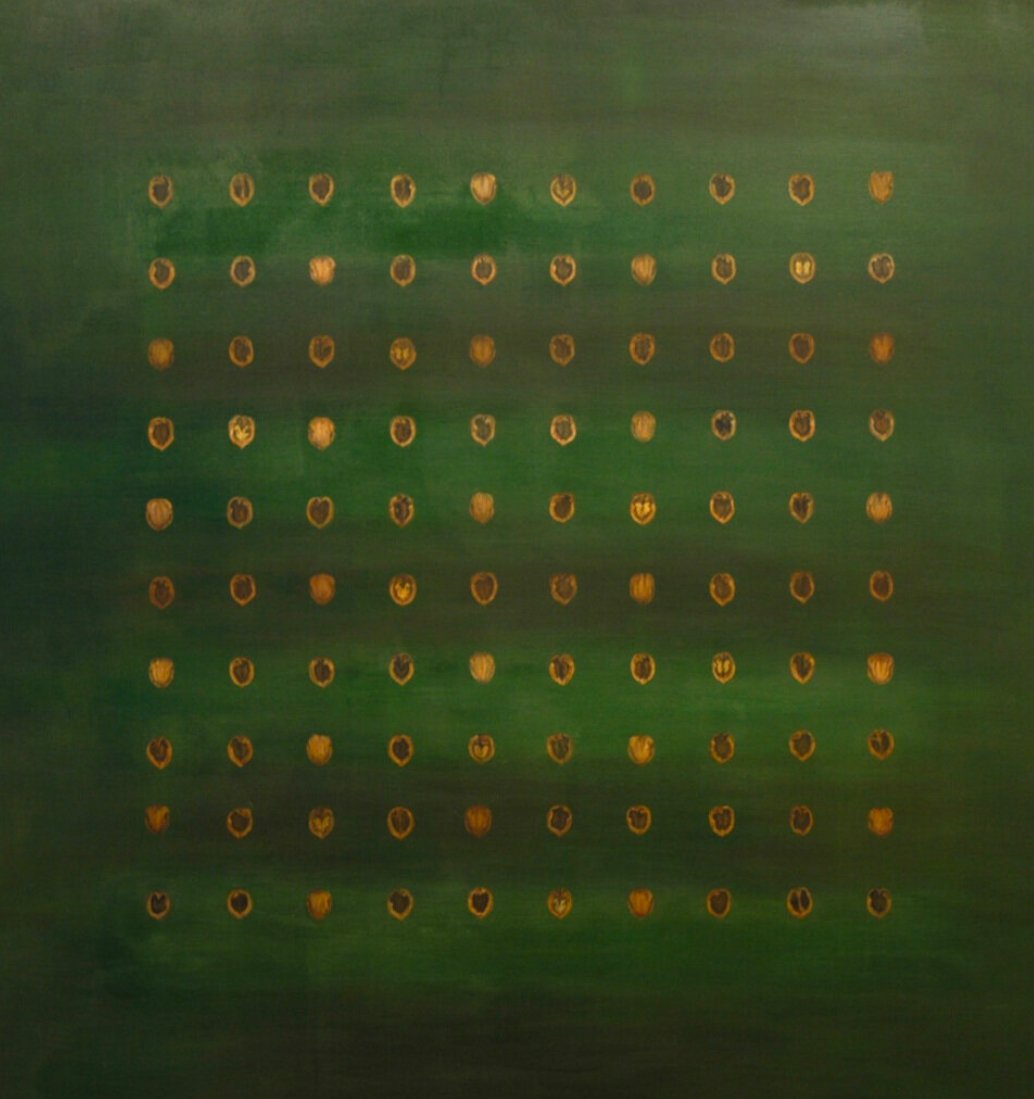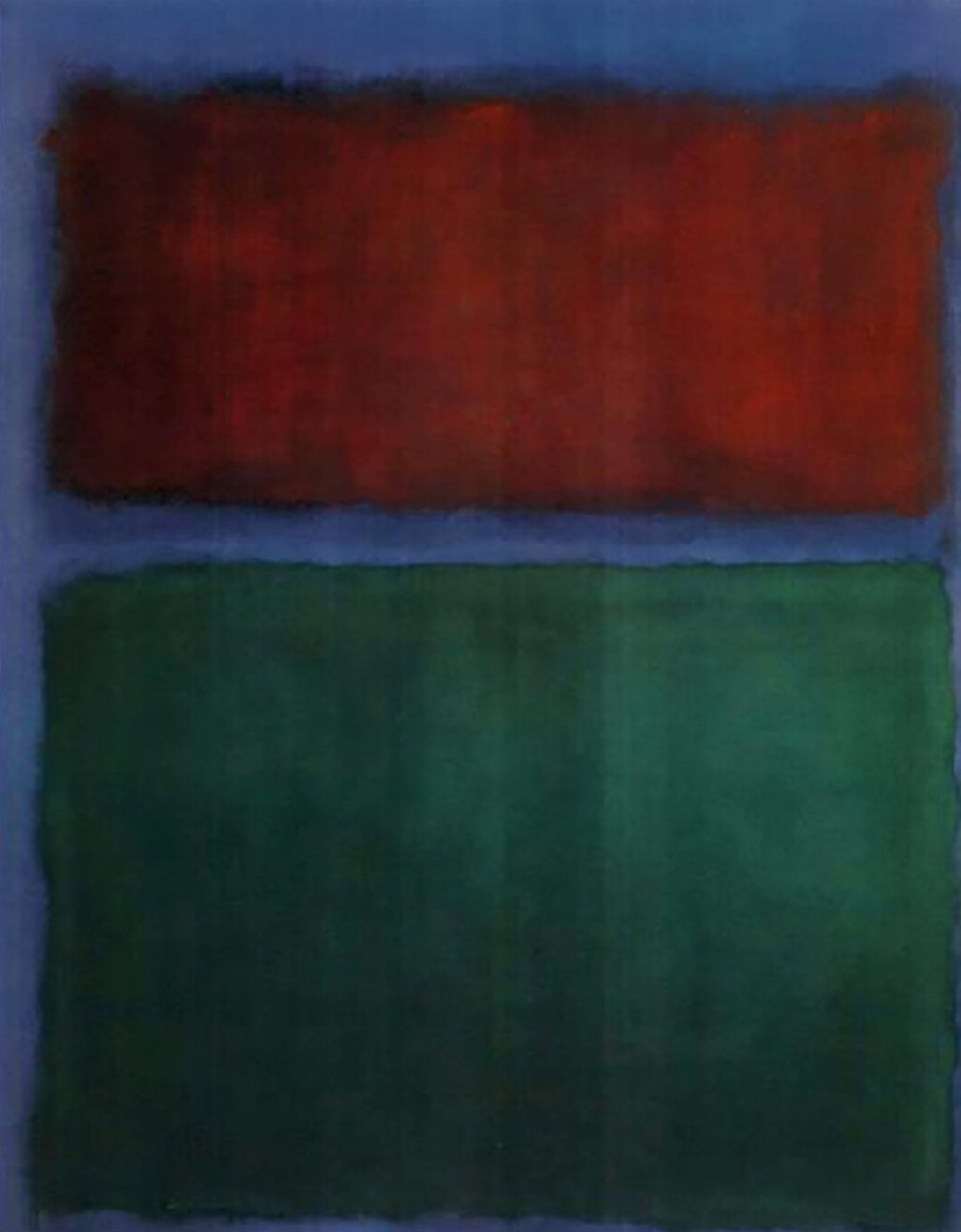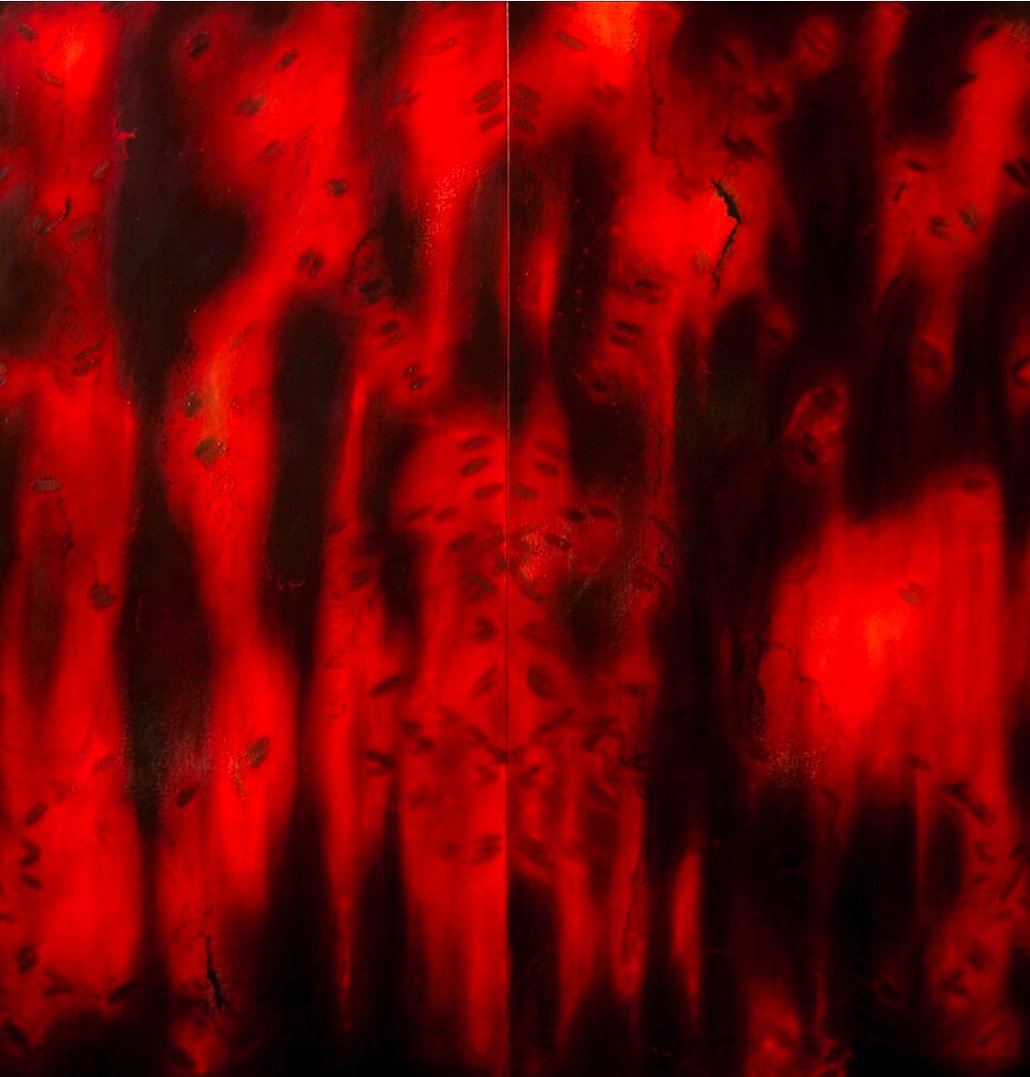Shane Guffogg, 1987, “100 Walnuts”, acrylic on canvas, 57 x 57 inches
"Art as a Path to Connection: Rothko, GuFFogg, and the Pursuit of Transcendence"
Written by Victoria Chapman
Spirituality is an intrinsic part of the human experience—a vital element that offers solace in moments of doubt, depression, or a yearning for connection. It serves as a grounding force for joy, providing an anchor in life’s ebb and flow. Art, as a conduit for spirituality, invites viewers to step into a deeply personal dialogue, one that fosters stillness and contemplation. Both Mark Rothko and Shane Guffogg create works that resonate profoundly with this spiritual dimension. Their approaches and inspirations, though distinct, reveal a shared pursuit of transcendence through art.
Mark Rothko’s iconic bands of color demand a stillness from the observer, almost paralyzing the senses as one immerses in their vastness. The experience is transformative, as these abstract fields of color hold a certain truth, drawing the viewer into a dialogue with time and space. His work becomes a mirror for the soul, reflecting back emotions that range from despair to hope. Rothko’s ability to evoke profound emotion through pure color was groundbreaking. Shane Gu6ogg observed, “His ability to have pure color and be able to evoke those kinds of emotions, for me... it gave me permission to say, ‘Okay, how can I...’ I too wanted to make spiritual art. I too wanted to make art that, when I first stood in front of a Rembrandt painting, what I felt inside of me. When I first stood in front of a Monet Water Lily painting, what I felt inside. And to me, that feeling was—I equated that with a sense of spirituality.”
Mark Rothko, 1955 “Earth Green” oil painting, 31 x 24 inches, photo credit- public domain
Guffogg’s work evokes a similar spiritual call, though through a distinct language of veils and light. His compositions, with their fluid ribbons of line, create a rhythmic dance that transports the viewer. These layers of translucent color and movement beckon one to explore the interplay of light and shadow, presence and absence, form and formlessness. Guffgg’s work feels like a meditation in motion, inviting the observer to linger in the present moment and engage with the infinite.
Reflecting on his artistic journey, Guffogg admitted that his initial reaction to Rothko’s work was one of confusion: “In the beginning, when I first discovered Rothko, I didn’t understand it at all, and I thought it was a bunch of hooey, quite frankly.” This perspective changed as he grew older and encountered other artists. “And then as time went on, I began to have more of an understanding of what he was doing,” he said. “I came about understanding his work via three other artists. The first being Turner, the second being Monet, and the third being Kandinsky. So, once I learned about those artists, then suddenly his work made more sense to me, and I realized that what he was after was this idea of spirituality and art. The other artists’ works were pointing towards that, but he wanted his work to be that. A big di6erence there. Right?”
j.m.w. turner, 1838 “flint castle” watercolor on paper, photo credit- public domain
claude monet, c 1920, “reflections of clouds on a lily pad”, oil on canvas, 78.74 x 502.36 inches photo credit- public domain
Wassily kandinsky, 1925, “Yellow, Red, Blue” oil on canvas, 50.39 x 79.1 inches, this image lives in Musée National d'Art Moderne - Paris, Photo credit: public domain
Mark Rothko (born Markus Yakovlevich Rothkowitz on September 25, 1903, and later changing his name in 1940) was an influential American abstract painter. His most famous works are his color field paintings, created between 1949 and 1970, which feature irregular, painterly rectangles of color. While Rothko didn’t align himself with any specific artistic school, he is often linked to the American abstract expressionism movement in modern art. (wikipedia) photo credit: public domain
mark rothko, 1956, “orange and yellow” oil painting, 90 x 70 inches, photo credit: public domain
For Guffogg, spirituality in art is not about religions but rather a connection to something greater than oneself. When asked to define spirituality, he explained, “The feeling of being connected to something beyond myself... Something that I can’t even put my finger on. I certainly can’t put words to it. It’s just something that’s there.” He rejected the notion that spirituality in art must be tied to a higher deity, emphasizing instead a universal connectivity: “I feel a connection to everything. And I feel like suddenly I am a part of history, a part of all of humanity. And that’s a profound feeling to have, that you’re not all alone in the world.”
Guffogg’s practice bridges the classical techniques of past masters with contemporary sensibilities, much like Rothko bridged the legacy of artists like Turner, Monet, and Kandinsky. Gu6ogg cited Turner’s late works, with their atmospheric glazes, as instrumental in shaping Rothko’s approach to light and space. He remarked, “Turner was recreating how we look through the atmosphere and how we see light. Rothko couldn’t have happened without Turner doing what he did. I don’t think Rothko could have happened without Kandinsky exploring his ideas of spirituality... or without Monet making those water lily paintings because of the idea that there was no horizon line and the purity of color that he was pursuing as well.” Rothko’s abstraction took these influences further, reducing visual language to pure, emotive color fields. “What he was doing was sensorial,” Guffogg reflected, “He was pursuing his ideas of spirituality in a way that matched his time. My time is different, so I’m going to see it in a different way.”
Shane Guffogg, 1993, “Untitled 84” oil on canvas, 72 x 72 inches
Guffogg’s work, while influenced by Rothko, introduces his own unique language of veils and ribbons of light. His paintings, layered with translucent color and dynamic line, create a sense of movement and depth. These elements encourage viewers to linger, to explore the interplay of light and shadow, presence and absence, form and formlessness. For Gu6ogg, this exploration mirrors the human experience—a journey of discovering patterns, connections, and meaning.
In discussing his process, Gu6ogg revealed how personal rhythms inform his art: “If I subconsciously make a brushstroke and then consciously replicate that brushstroke and then mirror that brushstroke... out of this subconscious moment comes a conscious patterning. And that’s how we live our lives... These are patterns in our lives based on our movements, based on our emotions. And that’s what I was interested in, to find out what my patterns look like.”
Ultimately, both Guffogg and Rothko challenge viewers to engage with art as a deeply personal and spiritual experience. Through their works, they create spaces for introspection, connection, and transcendence. As Guffogg observed, “Art’s purpose is to maintain a connection to our humanness.” By embracing this purpose, both artists offer viewers a sanctuary where they can explore the infinite—a dialogue of color, light, and emotion that speaks directly to the soul.
Shane Guffogg, 2024 “And the End and the Beginning were Always There #1” oil on canvas, 20 x 16 inches, currently on display at gallery chang, new york city
Shane Guffogg was born in Los Angeles on August 12, 1962. At four, his family moved to Lindsay, a farming town in the San Joaquin Valley, and later to Strathmore in 1975 to run an exotic bird farm. During his teenage years, Guffogg worked on the farm and discovered his passion for art, building a studio there with his parents' support. After graduating high school in 1980, he toured European art museums, where he realized that art is its own language, capable of expressing what words cannot. This understanding influenced his work, which often uses patterns, visual depth, and light to evoke emotion and explore concepts like Quantum Physics and Super String Theory.
Guffogg’s work spans various mediums, including oils on canvas or paper, watercolors, gouache, pastels on paper, and traditional etchings on zinc plates. His pieces range in size from 10” x 8” to 10’ x 8’. His oil paintings, rooted in European Master techniques, often feature 60 to 70 layers of translucent colors mixed with a glazing medium, giving them an illuminated quality. Guffogg began studying art at a local community college before joining CalArts in 1983, encouraged by artist Joe Goode. At CalArts, he was mentored by conceptual artist Douglas Huebler and earned his B.F.A. in 1985. He later worked as an assistant to Ed Ruscha and Joe Goode from 1989 to 1995.
To this day, Guffogg continues to create art in California and displays his work in galleries and museums both domestically and internationally. (wikipedia)









